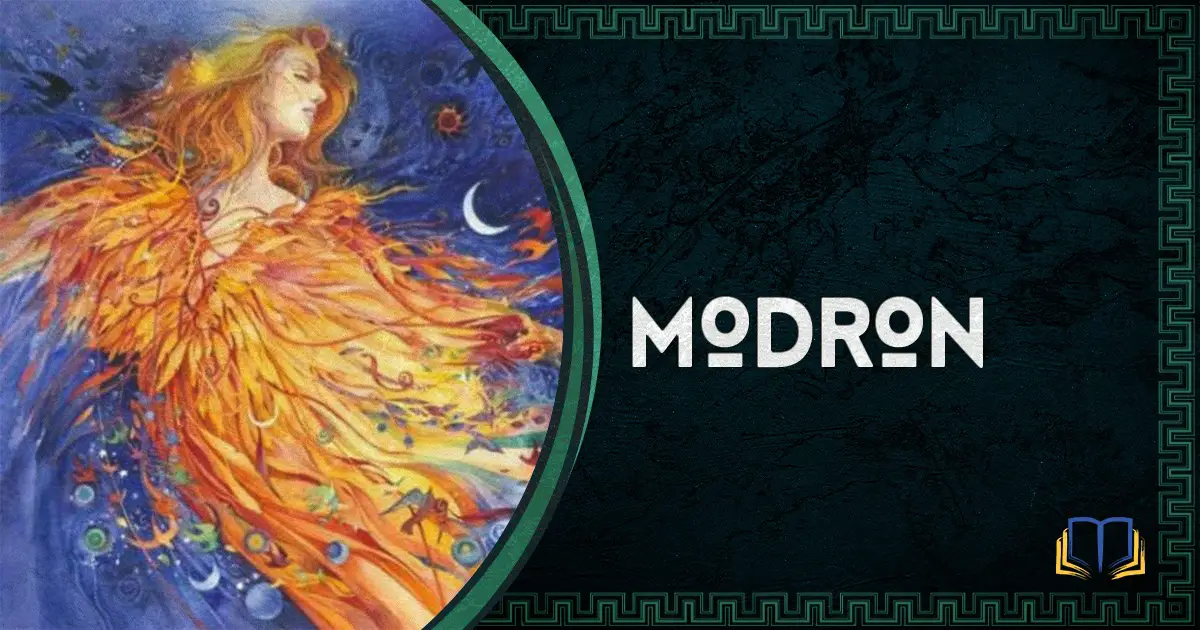Little is known about the Welsh mythological figure Modron. She is best known as the mother of Mabon in certain Arthurian legends. As such, she is mainly considered a mother figure or a goddess of fertility, and may have been confused with other similar figures from across Europe.
Origins
There is little remaining evidence that directly relates to Modron. She appears in the Welsh tale titled Culhwch and Olwen, which is connected to the legends of King Arthur. The earliest mention of the name Modron is thought to have been in the fragmentary Welsh poem Pa Gur yv y Porthaur, in which Arthur converses with a gatekeeper, telling of his exploits and referencing earlier tales that are now lost to history.
There are a number of other fragmentary texts which mention Modron. These include The Welsh Triads and Cad Goddeu, the details of which we’ll discuss in the Myths section below.
Also, don’t forget to visit our Celtic Mythology hub, where we have a LOT more articles like this one.
Appearance and Abilities
Modron’s name is said to be based on the Gaulish eponym of the Marne River, Matrona, meaning “Great Mother.” As such, it’s easy to see how this association fits with her as the goddess of fertility, as rivers were important for agriculture.
Modron is depicted in different ways depending on the source. The Romans may have depicted her as a triple-aspect goddess in the form of three seated women, each holding a different object with connotations of fertility. These objects were often fruit, loaves, and babies. In this aspect, the Romans called her Deae Matres or the Matronae.
She may be depicted on a stone carving from the Roman fort at Ribchester holding Mabon as an infant.
She may also be the basis for Morgan le Fay, who is depicted as a goddess, a witch, a temptress, and a sorceress, depending on the story.
Modron Myths
Modron is mentioned in a few different texts, mostly in passing. We’ll start with the earliest known mention of her.
“What Man is the Gatekeeper?”
A 13th century manuscript known as The Black Book of Carmarthen includes the poem Pa gur yv y porthaur?, which means “What Man is the Gatekeeper?” Sometimes known simply as Pa gur, this is the 31st poem in The Black Book of Carmarthen, and also the earliest known mention of Modron.
The poem is in the form of a conversation between King Arthur and the gatekeeper Glewlwyd Gafaelfawr. The gatekeeper wants to know who is in Arthur’s party and asks Arthur to vouch for them. This is when Modron is mentioned, but only in regards to her son. As Arthur lists off his men, he mentions Mabon, son of Modron. We learn more about Modron in later works, although most of them still focus on her as the mother of Mabon.
Culhwch and Olwen
Culhwch and Olwen is the longest surviving Welsh prose texts. It also includes the most substantial mention of Modron. In it, Modron gives birth to Mabon, but the infant is stolen by unknown adversaries when he is three days old.
King Arthur comes into play here, as one of his quests involves rescuing Mabon from his captors. With the help of several wise animals, Arthur’s men locate Mabon and proceed to rescue him amidst a fierce battle. Mabon then joins their ranks and travels with Arthur and his men on their adventures.
The similarities between certain aspects of this tale and another myth of the Great Prisoner make some think that Modron and Mabon were based on that earlier tale. The Great Prisoner is stolen from the Great Mother and taken out of Annwfyn, or the Celtic otherworld and then held captive.
The Welsh Triads
The Welsh Triads, a collection of medieval texts concerning Welsh mythology, history, and folklore, contains another mention of Modron. In Triad number 70, Modron gives birth to twins, Owain and Morfudd after Urien Rheged comes across her at a ford. In the text, she is a washerwoman that Urien comes across while investigating the ford in Denbighshire. She identifies herself as the daughter of Afallach, who appears in several other medieval Welsh texts and is apparently connected to the island of Avalon.
After Urien fornicates with Modron, she tells him that she had been condemned to wash at the ford until she gives birth to a son conceived by a “Christian” man. Urien returns to the ford a year later to find that she has given birth to the twins Owain, a boy, and Morfudd, a girl.
Conclusion
Modron’s appearances in the few remaining texts all indicate that she is some kind of otherworldly mother figure. Whether she’s known as the mother of Mabon or the mother of the twins Owain and Morfudd, her role in these ancient texts give credence to the idea that she is a goddess of fertility.
Roman texts about the Celts living in Gaul mention her using the names Deae Matronae or Dea Matrona. She’s considered The Great Mother and is seen bearing fruit, loaves, and babies.
Taken together, these mentions of her, although brief, give a good idea of her probable role in Welsh mythology.
Bibliography
- James MacKillop – A Dictionary of Celtic Mythology
- Proinsias Mac Cana – Celtic mythology (Library of the world’s myths and legends)
- Philip Freeman – Celtic Mythology: Tales of Gods, Goddesses, and Heroes
- Margaret Alice Murray – The God of the Witches
Arthurian Bibliography
- Norris Lacy, Geoffrey Ashe, Debra Mancoff – The Arthurian Handbook (Second Edition)
- Alan Lupack – The Oxford Guide to Arthurian Literature and Legend
- Ronan Coghlan – The Illustrated Encyclopaedia of Arthurian Legends
- Anonymous – Lancelot-Grail, the French Vulgate
- Sir Thomas Malory – Le Morte d’Arthur
See also my ever-expanding list of primary and secondary sources.



